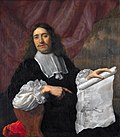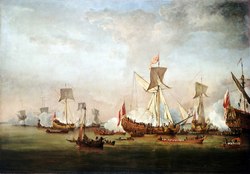The_Departure_of_William_of_Orange_and_Princess_Mary_for_Holland,_November_1677_RMG_BHC0322.tiff

Summary
|
Willem van de Velde the Younger
:
The Departure of William of Orange and Princess Mary for Holland, November 1677
|
|||||||||||||||||||||||||||
|---|---|---|---|---|---|---|---|---|---|---|---|---|---|---|---|---|---|---|---|---|---|---|---|---|---|---|---|
| Artist |
|
||||||||||||||||||||||||||
| Author |
Willem van de Velde, the Younger
|
||||||||||||||||||||||||||
| Title | |||||||||||||||||||||||||||
| Object type |
painting
object_type QS:P31,Q3305213
|
||||||||||||||||||||||||||
| Genre |
marine art
|
||||||||||||||||||||||||||
| Description |
English:
The Departure of William of Orange and Princess Mary for Holland, November 1677
This picture shows the embarkation of Prince William of Orange and Princess Mary, his new wife, at Erith, Kent, on their journey to the Netherlands on what is often called the 'honeymoon voyage'. William married Mary, daughter of James, Duke of York, on 4 November 1677 at Whitehall Palace. Some days after their marriage the Prince and Princess were accompanied by Charles II and the Duke to Erith, where they boarded separate yachts for their return to Holland. Contrary winds then forced them to disembark at Sheerness and go by coach to Margate. A further embarkation from there on 26 November was equally abortive and they had to come ashore again and did not reach their final destination until December. Eleven years later they were to return to England to become King William III and Queen Mary II, when Mary's father, then James II, was deposed. The picture shows the yachts and their escort preparing to get under way. The most prominent vessel is the 'Mary' a smack-rigged royal yacht shown in starboard-broadside view, with the Prince standing and recognizable because he is wearing a hat. The yacht is wearing the Prince's standard, a special Anglo-Dutch one designed for the occasion, and has her main-sail clewed up and her topsail aback. She appears to be waiting the delivery of a large trunk, shown in the galley about to go alongside her. A number of boats, including three barges hover near her and she is saluting to port. Beyond her to the right is another yacht with her anchors weighed, in starboard-bow view, and on the extreme right is the stern and starboard quarter of a two-decker. In the left foreground is a small bezan-rigged boat under oars, with two wherries nearby. In the left-hand side of the picture and further away can be seen three more yachts in starboard-bow view and two ships almost hidden by gun smoke. In the left middle-distance is the 'Charlotte', the yacht into which Princess Mary is embarking. Her standard is shown furled at her masthead. Later the Prince also moved onto this yacht. Near the 'Charlotte' is another state barge making-off up river on the flood. There is a yacht in starboard-bow view on the 'Mary's' port bow and further up river there are two other yachts and two ships, besides the 'Charlotte'. The land in the background is the north shore of the Thames, probably about Coldharbour Point.
Willem van de Velde the Elder was on board the 'Mary' and drew a numbered series of drawings throughout the voyage. The artist was the younger son of Willem van de Velde the Elder. Born in Leiden, he studied under Simon de Vlieger in Weesp and in 1652 moved back to Amsterdam. There he worked in his father's studio and developed the skill of carefully drawing and painting ships in tranquil settings. He changed his subject matter, however, when he came with his father to England in 1672, by working on views of royal yachts, men-of-war and on storm scenes. From 1672 the depiction of sea battles from the English side became a priority but unlike his father's they were not usually eyewitness accounts. However, from early 1674 both the van de Veldes were expressly patronized by Charles II for this purpose, the father to draw sea fights and the son - who was by far the more accomplished painter - 'for putting the said Draughts into Colours'. After his father's death in 1693 he was officially engaged to be present at and record significant maritime events. He continued to run a substantial and influential studio until his own death and with his father, especially as a painter, he is regarded as founder of the English school of marine painting. The painting is signed on the back 'W.V.Velde J'.
|
||||||||||||||||||||||||||
| Date |
after 1677
date QS:P571,+1677-00-00T00:00:00Z/7,P1319,+1677-00-00T00:00:00Z/9
|
||||||||||||||||||||||||||
| Medium |
oil
on
canvas
|
||||||||||||||||||||||||||
| Dimensions | Painting: 1270 mm x 1829 mm; Frame: 1610 mm x 2180 mm x 135 mm | ||||||||||||||||||||||||||
| Collection |
institution QS:P195,Q7374509
|
||||||||||||||||||||||||||
| Current location | |||||||||||||||||||||||||||
| Accession number |
BHC0322
|
||||||||||||||||||||||||||
| Notes | Signed. Depiction association: yacht Mary on right. | ||||||||||||||||||||||||||
| References | |||||||||||||||||||||||||||
| Source/Photographer | http://collections.rmg.co.uk/collections/objects/11814 | ||||||||||||||||||||||||||
|
Permission
( Reusing this file ) |
The original artefact or artwork has been assessed as public domain by age, and faithful reproductions of the two dimensional work are also public domain. No permission is required for reuse for any purpose. The text of this image record has been derived from the Royal Museums Greenwich catalogue and image metadata. Individual data and facts such as date, author and title are not copyrightable, but reuse of longer descriptive text from the catalogue may not be considered fair use . Reuse of the text must be attributed to the "National Maritime Museum, Greenwich, London" and a Creative Commons CC-BY-NC-SA-3.0 license may apply if not rewritten. Refer to Royal Museums Greenwich copyright . |
||||||||||||||||||||||||||
|
Identifier
InfoField
|
Acquisition Number: 1932-50
Caird Catalogue Number (CCAT): CC V1, P69, 417 id number: BHC0322 |
||||||||||||||||||||||||||
|
Collection
InfoField
|
Oil paintings | ||||||||||||||||||||||||||
Licensing
|
This is a faithful photographic reproduction of a two-dimensional,
public domain
work of art. The work of art itself is in the public domain for the following reason:
The official position taken by the Wikimedia Foundation is that "
faithful reproductions of two-dimensional public domain works of art are public domain
".
This photographic reproduction is therefore also considered to be in the public domain in the United States. In other jurisdictions, re-use of this content may be restricted; see Reuse of PD-Art photographs for details. |
|||||



